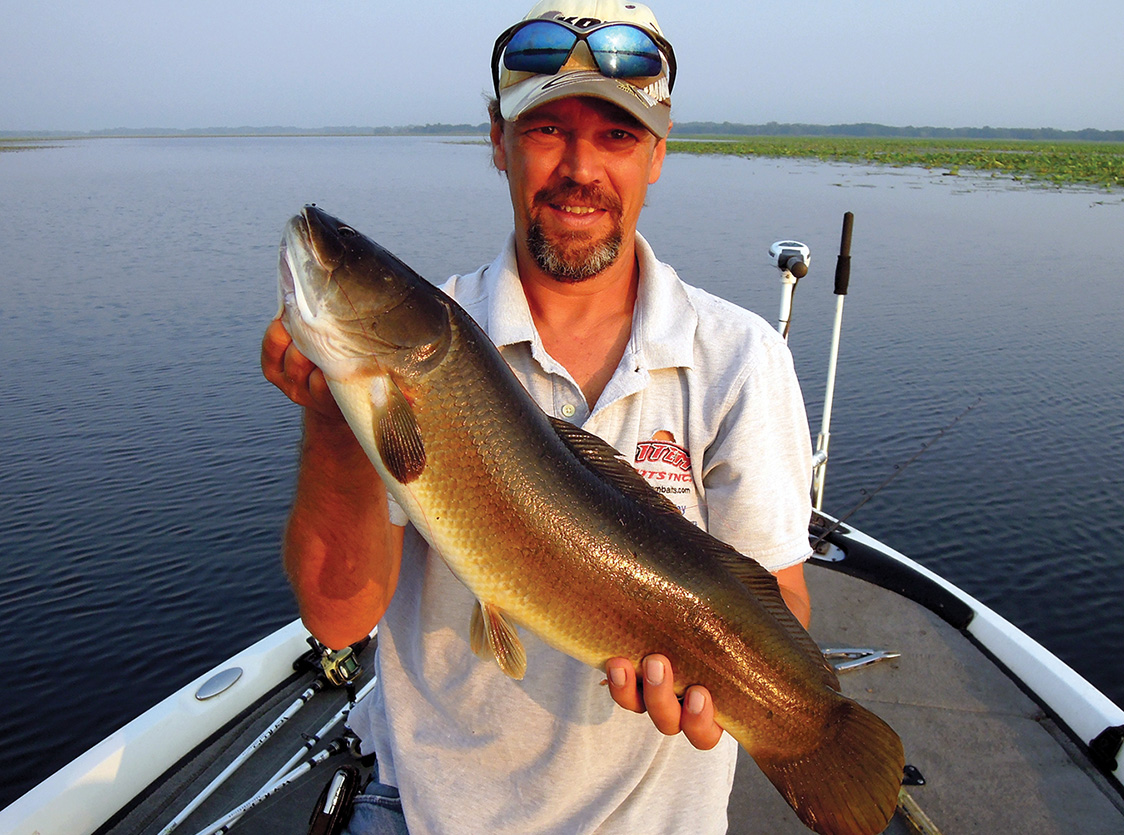
Primitive predators are always on the prowl
By John N. Felsher
At the drop-off edge, a cloud of brown silt suddenly erupted as a huge green head snatched the bass lure, throwing spray into the air as if someone threw a brick into the water. The powerful fish headed deeper into the channel, straining the line nearly to the breaking point.
“I think we got this tournament won,” the angler shouted enthusiastically to his partner. “Get the net. This one’s a monster. It must be … nuts, another mudfish! Never mind the net.”
Many anglers give a similar reaction when a mudfish or bowfin strikes. Anglers also call them grinnel, dogfish, cypress trout, cottonfish (because of the texture and flavor of its meat) and many other names unfit to print. Although some people eat them, many people describe the flavor of bowfin as something akin to eating wadded cotton soaked in swamp mud. Louisiana Cajuns call them “choupique,” an Anglicized version of a French translation of the Choctaw Indian word “shupik,” meaning mudfish.
No matter what anyone calls them, these amazing fish date back to the Jurassic Period about 150 million years ago. The only surviving representative of a primitive order, these fish witnessed the extinction of the dinosaurs and the giant mammals of the Ice Age, yet they remain unchanged. They survive because they can live practically anywhere and often inhabit the most stagnant waters.
Their swim bladders can serve as primitive lungs, allowing bowfins to breathe air and live in the foulest places. Bowfins can remain alive for long periods out of the water as long as they remain moist. People sometimes find them alive in semi-dried ponds resembling little more than mud puddles after a drought or when a falling river drains backwaters. Farmers even reported plowing them up alive in wet fields after floods.
“Bowfins can live in muddy backwater areas without much oxygen much better than most other species,” says Chris Greene of the Alabama Division of Wildlife and Freshwater Fisheries in Montgomery. “Bowfin is a native fish found throughout Alabama. They are more common in swampy backwater areas with a lot of shallow vegetation throughout the state.”
Although most anglers hold them in low regard because of their unsavory reputation on the dinner table, these large aggressive prehistoric predators can provide incredible sport, particularly on light tackle. Long and cylindrical with a rounded tail and an exceptionally long dorsal fin, a bowfin looks similar to an eel, but thicker with greenish-brown scales and a huge head with a mouth full of sharp teeth. Vicious predators, bowfins eat almost anything they can catch and frequently devour small fish, crawfish, frogs, salamanders, snakes and small animals, but few people intentionally fish for them.
“Bowfins hit hard and can put up a good fight, but are not normally targeted,” Greene says. “They can grow pretty big. It’s not uncommon to catch bowfins in the 5- to 10-pound range all across Alabama. Anglers mostly catch them by accident while fishing for bass or something else. Some archers target them in backwater areas.”
A bowfin may grow about 12 inches in its first year and live more than 30 years. The world record topped 21 pounds. Some larger specimens exceed three feet in length.
Big bowfin can challenge any type of bass tackle and may hit anything that might tempt a largemouth bass. Bass anglers catch them on spinnerbaits, crankbaits and Texas-rigged plastic worms. Bowfins also hit jigs dropped into thick cover, particularly around weeds or wood. Crappie anglers often catch them on live shiners. Bowfins might even hit nightcrawlers and other baits used by anglers targeting bream or catfish.
Since they can breathe air, bowfins thrive in rivers, quiet swampy backwaters, shallow ponds and lakes full of submerged aquatic vegetation all across the state. Flowing with muddy rivers and laced with numerous backwater bayous, creeks and sloughs, the Mobile-Tensaw Delta creates the perfect habitat for bowfins and probably holds the largest population in the state. Bowfins also thrive in the Alabama, Tombigbee, Black Warrior and the Tennessee river systems among other places.
Almost any warm, sluggish creek, bayou, canal or reservoir in the state probably holds a population of these fierce living fossils. After fighting one, release it to fight again tomorrow.
 John N. Felsher is a freelance writer and photographer who lives in Semmes, Ala. He co-hosts a weekly outdoors show that is syndicated to stations in Alabama. For more on the show, see www.gdomag.com. Contact him through his website at www.JohnNFelsher.com
John N. Felsher is a freelance writer and photographer who lives in Semmes, Ala. He co-hosts a weekly outdoors show that is syndicated to stations in Alabama. For more on the show, see www.gdomag.com. Contact him through his website at www.JohnNFelsher.com




